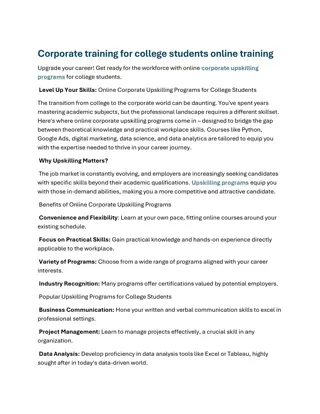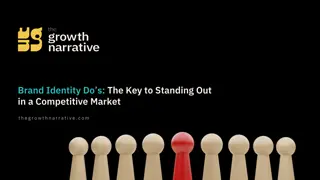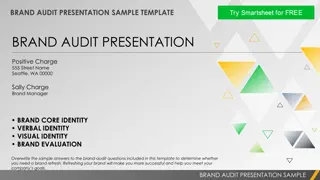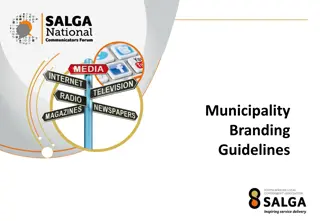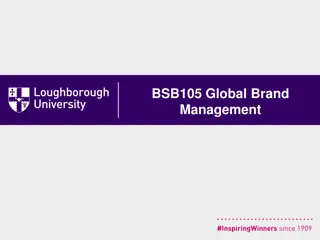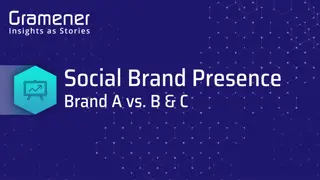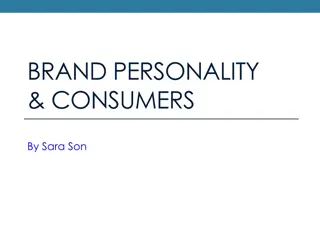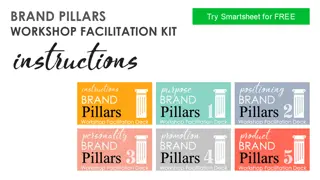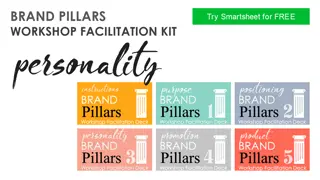Corporate Image and Brand Management Overview
This chapter delves into the management of corporate image and brands, covering topics such as developing brand names and logos, the importance of packaging, brand positioning strategies, and the components of corporate image. It explores perspectives from both consumers and companies, highlights the top global brands, and discusses corporate image development and identifying desired images. The benefits of logo recognizability are also emphasized.
Download Presentation

Please find below an Image/Link to download the presentation.
The content on the website is provided AS IS for your information and personal use only. It may not be sold, licensed, or shared on other websites without obtaining consent from the author.If you encounter any issues during the download, it is possible that the publisher has removed the file from their server.
You are allowed to download the files provided on this website for personal or commercial use, subject to the condition that they are used lawfully. All files are the property of their respective owners.
The content on the website is provided AS IS for your information and personal use only. It may not be sold, licensed, or shared on other websites without obtaining consent from the author.
E N D
Presentation Transcript
Corporate Image and Brand Management Chapter 2 2-1
Chapter Overview Managing a corporation s image and brands Developing and promoting brand names and logos Importance of packaging and labels Developing brand and corporate positioning strategies 2-2
Corporate Image Components of image Tangible Intangible 1. Product sold 2. Were sold 3. Where produced 4. All communications 5. Corp. name and logo 6. Packages and labels 7. Employees 1. Corporate, personnel, and environmental policies 2. Ideals and beliefs of corporate personnel 3. Culture of country and location of the company 4. Media reports 2-3
Consumer Perspective Provide assurance, psychological reinforcement Unfamiliar settings Little or no previous experience Reduce search time Provide Provide social acceptance 2-4
Company Perspective Extension name to new products. Ability to charge more Consumer loyalty More frequent purchases by customers Positive word-of-mouth Attracts higher quality employees 2-5
Top Corporate Global Brands Rank Company 1 Apple 2 Google 3 Coca-Cola 4 IBM 5 Microsoft 6 General Electric 7 McDonald s 8 Samsung 9 Intel 10 Toyota Brand Value Country of Ownership (billions) $98.3 $93.3 $79.2 $78.8 $59.5 $46.9 $41.9 $39.6 $37.3 $35.4 United States United States United States United States United States United States United States South Korea United States Japan Adopted from http://www.interbrand.com/en/best-global-brands/2013
Corporate Image Development Create, reinforce, or change image Overcome negative press 2-7
Identifying the Desired Image Evaluate current image Ask customers Ask non-customers Create strategic advantage
Logos - Benefits of Recognizability Aids in recall Specific brands Advertisements Reduces shopping effort Reduces search time 2-9
What colors should you use in your logo? Black seriousness, distinctiveness, boldness, power, sophistication, and tradition Blue authority, dignity, security, faithfulness, heritage, corporate stability, and trust Brown/gold history, utility, earthiness, richness, tradition, conservative Gray/silver somberness, authority, practicality, corporate mentality, and trust Source: Adapted from Jared McCarthy, Logos: What Makes Them Work (Part 1of 2), (www.marketingprofs.com/5/mccarthy4.asp), February 22, 2005.
What colors should you use in your logo? Orange fun, cheerfulness, warmth, exuberance, health, and youth Green tranquility, health, freshness, stability, and appetite Pink femininity, innocence, softness, health, and youth Purple sophistication, spirituality, wealth, royalty, youth, and mystery Source: Adapted from Jared McCarthy, Logos: What Makes Them Work (Part 1of 2), (www.marketingprofs.com/5/mccarthy4.asp), February 22, 2005.
What colors should you use in your logo? Red aggressiveness, passion, strength, vitality, fear, speed, and appetite White/silver purity, truthfulness, faith, contemporary, refined, and wealth Yellow youth, positive feelings, sunshine, cowardice, refinement, caution, and appetite Source: Adapted from Jared McCarthy, Logos: What Makes Them Work (Part 1of 2), (www.marketingprofs.com/5/mccarthy4.asp), February 22, 2005. 2-12
Types of Brands Co-Branding Family brands Brand extensions Flanker brands Private brands Ingredient Cooperative Complementary 2-18
Types of Brands Family brands Campbell s, GE, Kraft, Toyota Brand extensions Nike clothing, Porsche watches Flanker brands Healthy Choice, Shoebox Greetings, Scion Private brands Craftsman, Safeway Select, Kirkland 2-19
Types of Brands Types of Brands Co-Branding Ingredient Intel/HP, Hershey s/Betty Crocker Cooperative Amex/Costco, AA/CitiCard Complementary 7&7, Oreo Milkshakes 2-20
Developing Strong Brands Begins with understanding why consumers buy a brand. Where does your brand stand now? What are your objectives? What are your brand s strengths? Weaknesses? Which opportunities should be pursued first? Where are the pitfalls?
Measuring Brand Equity Brand Metrics Brand metrics measure return on branding investments. Attitudinal measures Awareness Recall Recognition Brand power index (BPI) 2-22
Benefits of Brand Equity(Fig 2.8) Higher prices, margins Channel power Additional retail shelf space Reduces customer switching Prevents erosion of market share
Brand Loyalty If not your brand, would you switch to another? (% of yes responses) Greeting cards Groceries and canned food Women s apparel Men s apparel Beverages Toys Candy Consumer electronics Computer software 68% 67% 50% 55% 49% 47% 47% 40% 35% Source: Adopted from Debbie Howell, Today s Consumers More Open To Try New Brands, DSN Retailing Today, vol. 43, No. 20 (October 25, 2004), pp. 29-31.
Private Brands Connotation of low price, low quality Historically price-sensitive consumers Retailers investing in private brands Believe equivalent to manufacturers brands - 72%
Changes in Private Brands Quality improvements Higher store loyalty Lower loyalty to manufacturer brands Increase in advertising/featuring of private brands 2-26
Product Positioning 1. Relative to competition. 2. Exists in the mind of the consumer. Attributes Competitors Use or application Price/quality Product user Product class Cultural symbol Markets Consumer B-to-B International 2-27
Packaging Traditional elements Protect the product Provide for ease of handling, placement Prevent or reduce theft, tampering New trends Meet consumer needs for speed, convenience, and portability Must be contemporary and striking Must be designed for ease of use 2-28
Packaging Packaging Final opportunity to make impression ~2/3 of purchase decisions made in- store Have 3 seconds to catch attention Needs to stand out Tells customers what is inside
Labels Must meet legal requirements Another marketing opportunity
Ethical Issues Brand infringement Brand name becomes a generic term Domain or cyber squatting 2-31
International Implications Adaptation vs. standardization Standardization reduces costs Shrinking world High-profile, high-involvement global brand Low-involvement products local brand Packaging and labeling Image and positioning issues standardization 2-32




